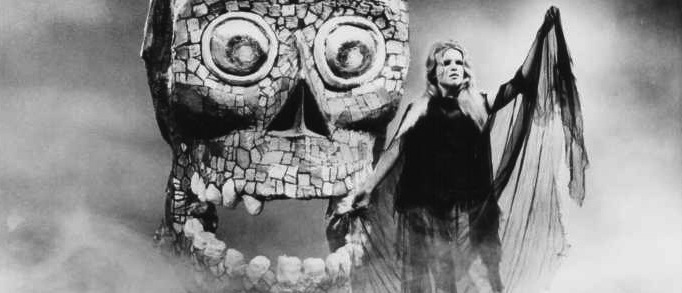CANADA'S FILM FIRSTS
May, 1979
THE PICTURES FIRST BEGAN to move on the 14th day of April, 1894. Back then, Canadians ran the show. The movies — or, more precisely, what would become the movies — were first shown commercially in The Kinetoscope Parlour, a New York City storefront on Broadway at the corner of 27th Street. The ten Edison Kinetoscope peep-show machines found therein were owned by George and Andrew Holland of Ottawa, Ontario. Within two years, the Kinetoscope had matured into the Vitascope, the great-grandaddy of today's projector-and-screen style of movie presentation. Three short months after the Vitascope's U.S. premiere, the Holland Brothers brought it home to Ottawa, offering Canada its first picture show on the evening of July 21, 1896. For most people, the "movies" has come to mean feature films, story-telling pictures shown in commercial movie houses. With that in mind, name the following Canadian feature film firsts:
1. The first Canadian-made feature.
2. The first Canadian-made sound feature.
3. The first Canadian-made colour feature.
4. The first Canadian-made feature in 3-D.
5. The first Canadian-made cartoon feature.
6. The first Canadian-made feature in a wide-screen process.
7. The first feature film to win a Canadian Film Award.
8. The first Canadian-made feature to win the U.S. Academy Award.
BONUS QUESTION:
On March 24, 1911, a law was passed creating the first governmentally-regulated film censorship in the English-speaking world. Where?
ANSWERS:
1. EVANGELINE (1913; d. William Cavanaugh) with Laura Lyman, John Carleton. Filmed on location in Nova Scotia's Annapolis Valley, Canada's first feature film was inspired by Longfellow's romantic poem about the Acadian expulsion and the lovely Evangeline's (Lyman) enduring love for her lost Gabriel (Carleton).
2. THE VIKING (1931; d. George Melford) with Charles Starrett, Louise Huntington, Arthur Vinton. The Newfoundland seal hunt was not nearly so controversial as it is today when producer Varick Frissell took his crew aboard the good ship Viking to film this man-against-the-elements drama, Canada's first sound feature.
3. ÉTIENNE BRÛLÉ, GIBIER DE POTENCE (1952; p./d. Melburn Turner) with Paul Dupuis, Jacques Auger, Ginette Letondal. The adventures of French-Canadian explorer and fur-trader Étienne Brûlé (c. 1592-c.1633), the first white man to live among the Indians, provided Melburn Turner with the material for Canada's first colour feature, shot in and around St. Adolphe in Quebec's Laurentian Mountains. English release title: The Immortal Scoundrel. (An earlier feature, 1938's Talbot of Canada, was shot in colour but never released commercially. The story of Thomas Talbot's Upper Canadian land grant, it was also produced and directed by Melburn Turner.)
4. THE MASK (1961; p./d. Julian Roffman) with Paul Stevens, Claudette Nevins, Bill Walker. A Toronto-made horror movie that tells the story of a psychiatrist (Stevens) who experiences other-worldly hallucinations was Canada's first feature film to incorporate 3-D sequences. Also known as Eyes of Hell.
5. LE VILLAGE ENCHANTÉ (1955; p./d. Réal and Marcel Racicot) The sound of a magic bell eases the hardship of pioneering life in frontier Quebec, and is central to the storyline in Canada's first animated feature. Produced by the Montreal-based Racicot brothers, it is known in English as The Enchanted Village.
6. THE DRYLANDERS (1963; d. Don Haldane) with Frances Hyland, James Douglas, Lester Nixon. A Boer War veteran (Douglas) and his wife (Hyland) become homesteaders in this gritty western filmed in and around Swift Current, Saskatchewan. The National Film Board's first English-language dramatic feature was also Canada's first widescreen movie. (The Canadians, a wide-screen Mounted Police melodrama released in 1961, has only quasi-Canadian status. It was a U.S. studio film, shot on location in Saskatchewan's Cypress Hills.)
7. TIT-COQ (1953; René Delacroix) with Gratien Gélinas, Monique Miller, Juliette Béliveau. Gélinas, later to become chairman of the Canadian Film Development Corporation, was the author of 1948's Tit-Coq, one of Canada's most successful stage plays. He adapted it for the screen, then proceeded to produce, co-direct and star in the film version, shot in Montreal. The story of an awkward French-Canadian Second World War veteran's adjustment to civilian life, it won the first Canadian Film Award for a feature film.
8. THE MAN WHO SKIED DOWN EVEREST (1975; Bruce Nyznick, Lawrence Schiller) Ottawa producer Budge Crawley collected the 1975 Academy Award for Best Feature Documentary for this study of Japanese adventurer Yuichiro Miura and his obsession with the world's most inaccessible ski run.
BONUS ANSWER:
Ontario. The actual machinery of censorship was up and running on June 27, 1911. The relevant law, called the Ontario Theatres and Cinematographs Act, predates the first U.S. governmental film censorship act by nearly three months.
Pennsylvania's State Board of Censors was created on June 19, 1911, but did not start work until February 1, 1914. The British Board of Film Censors, created in October, 1912, opened for business on January 1, 1913.
The above is a restored version of BUT FIRST . . , the introductory quiz included in The Canadian Movie Quiz Book by Michael Walsh, originally published in 1979. For additional information on this archived material, please visit my FAQ.
